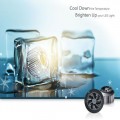 2012-04-03
2012-04-03
Light & Building 2012 Messe Frankfurt, Germany
Dates:April 15 – 20, 2012
Sunon Booth No.:Hall 4.0, G71
Increasing concern with environmental protection through energy-saving is driving the rapid decline of the incandescent light bulb and the growth of its replacement the LED Light bulb.
The increasing number of applications converting to LED light pushes this technology to achieve higher levels of efficiency and luminosity. Luminar designers and consultants are faced with increased costs and the design led aesthetic need for compa...
Continue reading →
2009-03-18
The thermal resistance of a material is its resistance against thermal conduction. The unit of thermal resistance is degree per watt, representing the temperature difference across a structure when a unit of heat energy flows through it in a unit time. After the LED is lighted and the thermal conduction stabled, as every watt of power on the chip surface being consumed, the temperature difference between the PN junction and the linking bracket or heating panel is the thermal resistance value of the LED.
Continue reading →
2009-01-20
Three innovative patent design
LED is energy-saving, vibration resistant, compact, and low in power consumption and attenuation; it also has other numerous advantages such as long service life, suitable for low-temperature environments, and high luminous efficiency. LEDs have much potential in indoor lighting development, yet their cooling problem is the bottleneck that affects high-power LED to be popularized.
Continue reading →
2008-01-10
When it comes to LED lights, many people focus on lumens and pay less attention to cooling. In fact, LED lumens are increasing rapidly. In 2006, lumens per watt in mass production reached 50 and it is still going up fast. Heat transfer theory has matured, its channels are clear: conduction, convection, radiation and phase change (such as heat pipes).
Continue reading →
2007-12-20
Unlike conventional incandescent lamps which need to convert the electricity into thermal energy first and then to light, LED illumination is achieved when a semiconductor crystal is activated so that it directly produces visible light in a desired wavelength range. With the continuous development of lighting technologies, more possible future applications of LEDs will be seen. Advantages and disadvantages of using LEDs are to be discussed as follows.
Advantages of LEDs
1. Long Lifespan
Continue reading →
 2012-04-03
2012-04-03